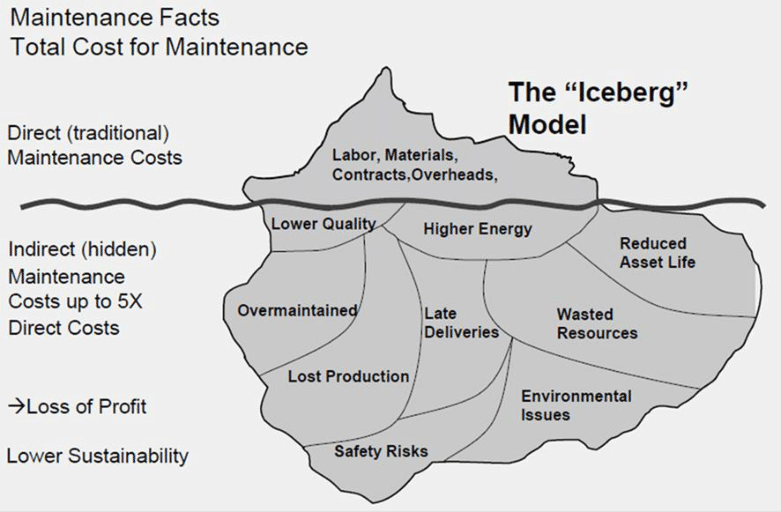Maintenance – The Tip of the Iceberg
18 Jun 2019

ike most words, maintenance has several meanings. In this context maintenance is the process of keeping something in an existing state (of repair, efficiency, or validity).
In self-organising biological systems from cells to landscapes, processes operate to repair and restore function. For example, wound healing is a complex repair process in which the skin and tissues repair themselves after injury.
Can anything ever be maintenance free? Well, not according to the second law of thermodynamics. In unmaintained open systems, entropy, or a tendency to disorder, is a constant source of change.
If maintenance is an essential process in one form or another, how can we better understand what’s involved? One way of looking at maintenance is in terms of activities, or more precisely the basis on which maintenance is undertaken in these activities.
In 1976, Swanson published a paper on the dimensionality of maintenance. The study looked at the problem of maintaining application software. The increasing complexity of computer systems meant the amount of time spent on software maintenance was becoming a serious issue. For organisations to effectively allocate resources they needed a better understanding of the types and causes of maintenance activity.
Swanson identified 3 types:
- Corrective maintenance – is undertaken in response to failures.
- Adaptive maintenance – occurs in response to changes in the environment.
- Perfective maintenance – aims to eliminate inefficiencies, improve performance, or maintainability.
Since the 1970s, maintenance processes and practices have improved and expanded to meet new challenges and accommodate technological change. For example, preventive maintenance, a correction type of maintenance, aims to detect and correct latent faults before they become operational faults.
An iceberg is known to have only ten percent of its total mass above the water while ninety percent of it is submerged under water. The iceberg model illustrates the scale of observable events, the tip of the iceberg, which are caused by systemic structures which are often hidden beneath the surface.

The iceberg model in Figure 1 provides an insight into the hidden costs of maintenance. It illustrates the scale of indirect costs from poor or inefficient maintenance. In an increasingly complex and interconnected world these costs will continue to increase unless smarter ways of doing maintenance can be found.
A recent incident drew attention to the fragility of the communities of highly skilled and dedicated software maintainers. The open source movement is behind much of the development and upkeep of software that powers our critical digital infrastructure. In 2014, the Heartbleed vulnerability, in the OpenSSL cryptographic library, revealed how much the integrity of the Internet relied on one software component designed and maintained by a small group of talented volunteers. In 2016, Eghbal identified a range of digital infrastructure risks and sustainability issues that if left unchecked would lead to a tragedy of the commons. It is therefore clear that we must also find sustainable ways of maintaining the maintainers.
The combination of machine intelligence, low-cost sensors, and the Internet of Things (IoT) means that predictive maintenance is becoming technically feasible and economically interesting. This innovation promises to elevate maintenance from an operational overhead to a profit contributor.
Maintenance may not appeal to everyone but it is a critical function in all systems. Maintenance has evolved from a non-issue into a strategic concern. Maintenance engineering and management are professions with a great future. Energy conservation, reducing pollution and waste, and tackling climate change are urgent issues. Predictive maintenance on the one hand offers predict and prevent, rather than find and fix, maintenance thereby reducing costs and maximising the lifespan of devices, equipment, machinery, installations, buildings and infrastructure. On the other hand, with the need for monitoring and data gathering, there are privacy concerns.
The Festival of Maintenance will be hosting speakers from a wide range of backgrounds. They will cover topics from the collaborative maintenance of data to predictive maintenance. Society is starting to recognise the hidden maintenance we’ve been neglecting. Be part of this emerging and fascinating field by attending this year’s event.
References
Barlow, M. Predictive Maintenance. O’Reilly Media, 2015.
Eghbal, N. Roads and Bridges: The Unseen Labor Behind Our Digital Infrastructure. Ford Foundation, 2016.
Gharajedaghi, J. Systems Thinking: Managing Chaos and Complexity: A Platform for Designing Business Architecture. Elsevier Science, 2011.
Holmgren, D. Permaculture Principles & Pathways Beyond Sustainability. Melliodora Publishing, 2017.
Pintelon L., Parodi-Herz A. Maintenance: An Evolutionary Perspective, Complex System Maintenance Handbook. Chapter 2. Springer-Verlag, 2008.
Swanson, E. B. The Dimensions of Maintenance. Proceedings of the 2nd International Conference on Software Engineering, 1976.
Wienker M., Henderson K., Volkerts, J. The Computerized Maintenance Management System an Essential Tool for World Class Maintenance. Procedia Engineering, 2016.
ISO/IEC 14764. Software Engineering – Software Life Cycle Processes – Maintenance. IEEE, 2006.